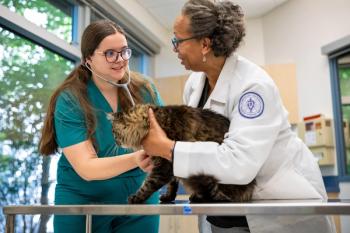
Changing trends in composition of feline uroliths and urethral plugs
Analysis: 1981 to 2006
Analysis: 1981 to 2006
Epidemiology of feline uroliths: 1981-2002
In 1981, calcium oxalate (Table 2) was detected in only 2 percent of feline uroliths submitted to the Minnesota Urolith Center, whereas struvite (Figure 1) was detected in 78 percent. However, beginning in the mid-1980s, a dramatic increase in the frequency of calcium oxalate uroliths occurred in association with a decrease in the frequency of struvite uroliths (Figure 2). From 1994 to 2002, approximately 55 percent of the feline uroliths submitted to the Minnesota Urolith Center were composed of calcium oxalate, while only 33 percent were composed of struvite. During this period, the decline in appearance of naturally occurring struvite uroliths associated with a reciprocal increase in calcium oxalate uroliths may have been associated with:
1) The widespread use of a calculolytic diet designed to dissolve struvite uroliths
2) Modification of maintenance and prevention diets to minimize struvite crystalluria (some dietary risk factors that decrease the risk of struvite uroliths increase the risk of calcium oxalate uroliths)
3) Inconsistent follow-up evaluation of efficacy of dietary management protocols by urinalysis.
Carl A. Osborne, DVM, PhD, Dipl. ACVIM
Epidemiology of feline uroliths: 2003-2005
In 2003, the frequency of calcium oxalate uroliths declined to 47 percent, while the frequency of struvite uroliths increased to 42 percent (Table 2). During 2004, the number of struvite uroliths (44.9 percent) submitted to the Minnesota Urolith Center nudged past those containing calcium oxalate (44.3 percent). In 2005, the number of struvite uroliths (48.1 percent) surpassed those containing calcium oxalate (40.6 percent) in frequency of occurrence.
Jody P. Lulich, DVM, PhD, Dipl. ACVIM
Epidemiology of feline uroliths: 2006
Of 10,093 feline uroliths submitted to the Minnesota Urolith Center in 2006, 5,001 (50 percent) were struvite, and 3,914 (39 percent) were calcium oxalate (Table 1).
The progressive decrease in occurrence of naturally occurring calcium oxalate uroliths during the past four years may be associated with:
- Reformulation of adult maintenance diets to minimize risk factors for calcium oxalate crystalluria.
- Improvements in formulation of therapeutic diets designed to reduce risk factors for calcium oxalate uroliths.
- Increased use of therapeutic diets designed to reduce risk factors for calcium oxalate uroliths.
The increase in appearance of naturally occurring struvite uroliths during the past four years may be associated with the reciprocal relationship between some dietary risk factors for calcium oxalate and struvite uroliths. For example, diets that reduce urine acidity and provide adequate quantities of magnesium reduce the risk of calcium oxalate urolith formation, but increase the risk of struvite (magnesium ammonium phosphate) urolith formation.
Table 1 Mineral composition of 10,093 feline uroliths and 551 urethral plugs submitted to the Minnesota Urolith Center during 2006
Figure 2: A 3-year-old domestic shorthair cat after digital manipulation of the distal urethra and manual compression of the urinary bladder. Fragments of a struvite-matrix urethral plug that had occluded the urethral lumen can be seen on the microscope slide.
The sustained increase in occurrence of struvite uroliths from 2003 to 2006 may be associated with decreased use of diets designed to dissolve sterile struvite uroliths as a consequence of the significant increase in occurrence of calcium oxalate uroliths in the 1980s and 1990s. However, it is likely that many of the 5,001 sterile struvite uroliths obtained from cats and submitted to the Minnesota Urolith Center in 2006 could have been readily dissolved in two to four weeks by feeding a diet designed to promote formation of urine that is under-saturated with struvite.
Figure 1: Struvite (magnesium ammonium phosphate) urolith removed from the urinary bladder of a 4-year-old male domestic shorthair cat.
Epidemiology of feline urethral plugs: 1981-2006
Of 551 urethral plugs submitted to the Minnesota Urolith Center by veterinarians in 2006, the mineral composition of about 87 percent was primarily struvite (Table 1; Figure 2). Approximately 1 percent were composed of calcium oxalate. Since 1981, struvite has consistently been the most-common mineral in feline urethral plugs; the prevalence of calcium oxalate in urethral plugs always has been infrequent (Table 3). The explanation as to why there have been significant shifts in the prevalence of calcium oxalate and struvite in feline uroliths during the past 25 years, while the prevalence of struvite and calcium oxalate in feline urethral plugs has not significantly changed is not obvious to us. We invite our readers to submit their thoughts on this apparent paradox. Whatever the reason(s), the high prevalence of struvite in urethral plugs is of clinical significance in terms of the design of dietary strategies to prevent their formation.
Table 2 Feline urolith distribution 1981-2006
Table 3 Feline plug distribution 1981-2006
Additional information may be obtained at
Newsletter
From exam room tips to practice management insights, get trusted veterinary news delivered straight to your inbox—subscribe to dvm360.





